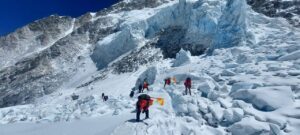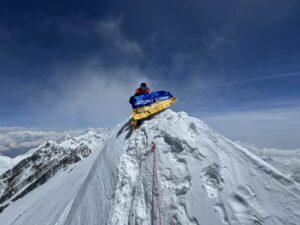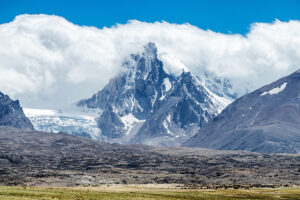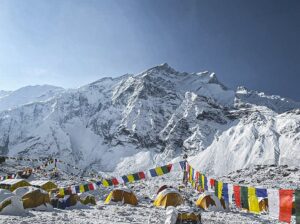As Annapurna action heats up, with summits possible as early as next week, we look at some past figures with a deep connection to this most dangerous 8,000’er. Today: Juan Oiarzabal
Juan “Juanito” Oiarzabal of Spain was the sixth person to complete the 14 8,000’ers, and the third to do it without supplemental oxygen. ExplorersWeb contacted him this week for some insight about Annapurna, a fearsome mountain that is surprisingly one of the most popular 8,000’ers this season.
Oiarzabal has summited Annapurna without O2 twice, both times from the north side. This first 8,000m peak ever summited — by Maurice Herzog’s 1950 French expedition — was Oiarzabal’s last on his quest to climb all the 8,000’ers. But leaving Annapurna until the end was fairly common in the 1990s.
“Annapurna filled us with respect,” Oiarzabal told ExplorersWeb. “It was a dangerous mountain with an alarming death rate. Of course, back then we would rarely fix ropes. Speed and not looking back was the key.”
As for supplementary oxygen, Oiarzabal snapped: “Are you kidding? Among our climbing crowd, you’d not even dare to mention it. It was simply not an option!”
Oiarzabal belongs to a golden generation of climbers from Spain’s Basque Country, a rugged region of steep limestone cliffs, thick birch forests, and the northern Atlantic Ocean. The idiosyncratic Basque culture is deeply rooted in the forces of Nature.
For many Basques, mountaineering is a way of life rather than a mere sport. The first three Spanish nationals to complete the 14×8,000m quest were Basque: Oiarzabal, Alberto Iñurrategui, and Edurne Pasaban, the first woman to accomplish it.
“We wanted to climb in the Himalaya, but we also wanted to do contribute with something more than reaching the summit: new routes or variations, self-sufficient climbs, and strong mountaineering ethics,” Oiarzabal recalled. The summit, if achieved, was a bonus: It was the way to reach it that counted.

Juanito Oiarzabal, centre, with Félix Iñurrategui, left, and his brother, Alberto Iñurrategui.
Even during the second stage of his climbing career, when Oiarzabal worked as a specialist on a Spanish documentary series called Al Filo de lo Imposible (On the Edge of Impossible), he deigned to climb in a more traditional expedition style in order to allow filming but still kept away from supplementary O2. The only exception was his first Everest summit in 1993, but he later summited Everest again without it, in 2001 from the North Side.

The summit of Everest? that way.
When he finished his all his 8,000’ers, he decided to do them again, again without O2. But the years had taken a toll, and he had some close calls and a couple of rescues. His hardest moment came after his second summit of K2, when he got lost in the dark on the way down, between the Bottleneck and Camp 4. It was only by coincidence that his partner Ferran Latorre, who had just set off on his own summit bid, found him lying nearly unconscious in the snow.
Oiarzabal was brought back to BC by the rest of the expedition, but he lost all his toes to frostbite. There were more expeditions, but also more frostbite, health problems, descents at the limits of exhaustion…Back at home, he was a celebrity, but fame is not so easy to manage either when one’s natural terrain is the lonely mountains.
His second ascent on Annapurna also ended bitterly: a frostbitten Oiarzabal was airlifted out while his partner, Tolo Calafat, who descended behind them exhausted and possibly with HACE, didn’t make it.

The toll of K2, 2004.
In the end, it took two pulmonary edemas after attempting Dhaulagiri twice in 2016 to decide to end an already lingering career. Oiarzabal quit high-altitude mountaineering and dropped his 2 x14 8,000’er record attempt after a total of 26 summits without oxygen, uncountably many memories, both sweet and bitter, some dear friends lost in the mountains, and a reputation for brutal honesty.
Ironically, after surviving 47 expeditions on 8,000m peaks, Oiarzabal was nearly defeated by COVID last month. He was taken to hospital with a severe case of pneumonia, complicated by the several times he had suffered from HAPE in the mountains, and the two pulmonary embolisms, souvenirs from Dhaulagiri.
As on K2, however, he somehow survived. The day he was sent back home three weeks later, he joked, “All the oxygen I had refused on the mountains, I finally had it at Txagorritxu [his town’s public hospital].”
He said that his escape from the hospital was the happiest day of his life. Clearly, the stubborn survivor of a hundred battles was not ready to go yet.

Oiarzabal faces a new stage after surviving COVID.
Today, Oiarzabal has not only recovered, but he is flying to Nepal in 10 days to guide a trek and to film the second part of a documentary about his life. Despite 68, Don Juan Eusebio Oiarzabal Urteaga, from Álava, is still known by everyone as “Juanito”, “Juanito Oiarzabal, el ochomilista [The 8,000 man].
These days, he seems to have moderated his legendary explosive temperament. He may be taking better care of his health. But his tone is somber when asked about the current four commercial expeditions on Annapurna, most of whose members climb on oxygen after a Sherpa team fixes the entire route.
Some years ago, Oiarzabal might have burst onto one of his rants. Now, his voice shows only sadness. “Himalayan climbing is going backward,” he says. “The helicopters, the taming of mountains with ropes, the lack of will to do something new…
“There is no solution for Everest, but the rest of 8,000’ers are going the same way…I am sorry most of all for K2. It was a wild place, where you could still feel a mighty power. But now they have left it…vulnerable.
“I can only speak for myself and I can honestly say that I have always done my best to climb mountains in the most ethical and aesthetic way possible. But the times I knew are gone.”






